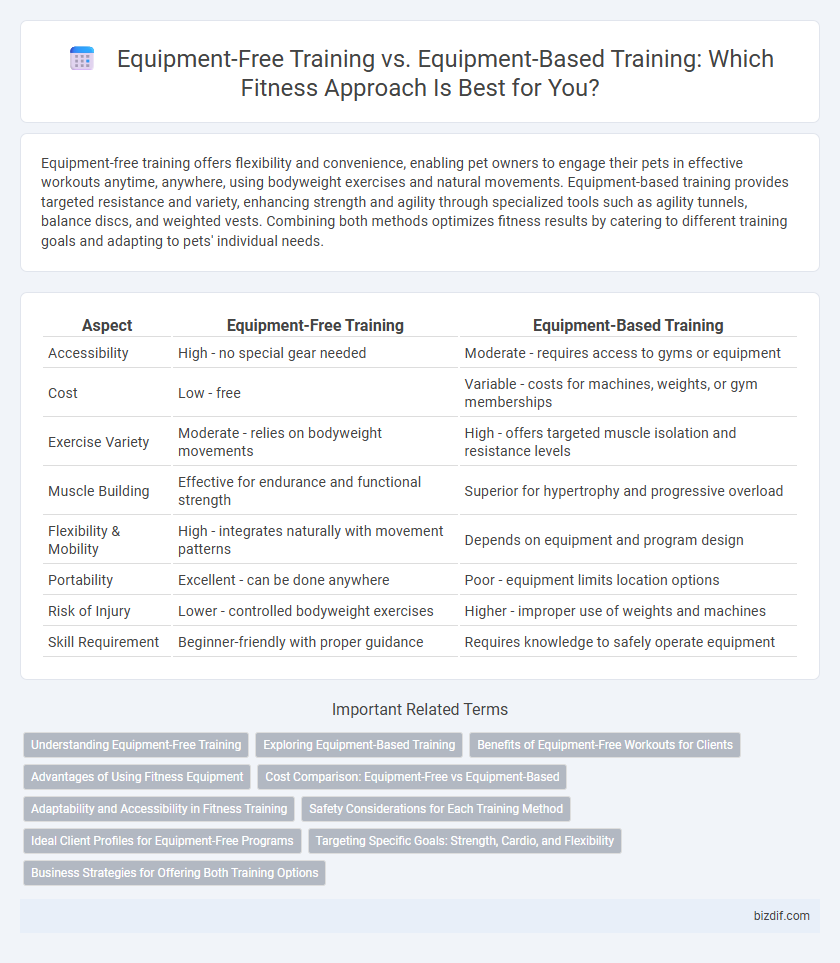Equipment-free training offers flexibility and convenience, enabling pet owners to engage their pets in effective workouts anytime, anywhere, using bodyweight exercises and natural movements. Equipment-based training provides targeted resistance and variety, enhancing strength and agility through specialized tools such as agility tunnels, balance discs, and weighted vests. Combining both methods optimizes fitness results by catering to different training goals and adapting to pets' individual needs.
Table of Comparison
| Aspect | Equipment-Free Training | Equipment-Based Training |
|---|---|---|
| Accessibility | High - no special gear needed | Moderate - requires access to gyms or equipment |
| Cost | Low - free | Variable - costs for machines, weights, or gym memberships |
| Exercise Variety | Moderate - relies on bodyweight movements | High - offers targeted muscle isolation and resistance levels |
| Muscle Building | Effective for endurance and functional strength | Superior for hypertrophy and progressive overload |
| Flexibility & Mobility | High - integrates naturally with movement patterns | Depends on equipment and program design |
| Portability | Excellent - can be done anywhere | Poor - equipment limits location options |
| Risk of Injury | Lower - controlled bodyweight exercises | Higher - improper use of weights and machines |
| Skill Requirement | Beginner-friendly with proper guidance | Requires knowledge to safely operate equipment |
Understanding Equipment-Free Training
Equipment-free training emphasizes bodyweight exercises such as push-ups, squats, and planks, which improve strength, flexibility, and endurance without the need for gym equipment. This training method enhances functional fitness and can be performed anywhere, increasing accessibility and convenience for users. Research shows that equipment-free workouts effectively build muscle and boost cardiovascular health while reducing injury risks associated with heavy equipment.
Exploring Equipment-Based Training
Equipment-based training offers targeted resistance through tools like dumbbells, resistance bands, and kettlebells, enhancing muscle growth and strength gains more effectively than bodyweight alone. Machines and free weights provide controlled motion paths and adjustable loads, allowing for precise progression and reduced injury risk in structured workout plans. Incorporating diverse equipment facilitates balanced muscle development and accommodates various fitness levels and rehabilitation needs.
Benefits of Equipment-Free Workouts for Clients
Equipment-free workouts enhance functional strength by utilizing body weight movements that engage multiple muscle groups simultaneously, promoting better coordination and balance. These workouts increase accessibility, enabling clients to train anywhere without the need for costly or bulky equipment, making consistency easier to maintain. Increased adaptability allows workouts to be easily modified to suit varying fitness levels, reducing injury risk and fostering long-term adherence.
Advantages of Using Fitness Equipment
Fitness equipment enhances workout efficiency by providing resistance and support that target specific muscle groups, leading to faster strength gains. Machines and weights enable precise control over exercise intensity and form, reducing injury risk and promoting consistent progress. Incorporating equipment-based training allows for versatile routines that adapt to various fitness levels and goals, optimizing performance outcomes.
Cost Comparison: Equipment-Free vs Equipment-Based
Equipment-free training offers a significant cost advantage by eliminating the need for purchasing expensive gym equipment, making it accessible for all budgets. Equipment-based training requires an upfront investment in machines, weights, or memberships, which can range from hundreds to thousands of dollars depending on the equipment's quality and complexity. Over time, equipment-free workouts reduce ongoing costs, while equipment-based approaches may involve maintenance and upgrade expenses, impacting the overall financial commitment.
Adaptability and Accessibility in Fitness Training
Equipment-free training offers unparalleled adaptability by allowing workouts to be performed anywhere, making it ideal for individuals with limited space or budget. Equipment-based training provides targeted muscle engagement and progressive resistance but requires access to specific tools and facilities, which may limit accessibility. Combining both approaches can enhance fitness results by tailoring exercises to personal goals and available resources.
Safety Considerations for Each Training Method
Equipment-free training reduces injury risk by minimizing dependence on machines, promoting natural body movements, and improving joint stability through controlled exercises like bodyweight squats and planks. Equipment-based training requires proper technique and equipment maintenance to prevent accidents, with risks such as improper weight handling or machine malfunction potentially causing strains or injuries. Both methods benefit from gradual progression, proper warm-up, and attention to form to ensure safety and maximize training effectiveness.
Ideal Client Profiles for Equipment-Free Programs
Equipment-free training is ideal for individuals seeking flexible workout options without the need for costly or bulky gear, such as busy professionals, travelers, and beginners focusing on bodyweight strength and mobility. Clients prioritizing convenience, minimal space usage, and functional fitness benefit from programs emphasizing calisthenics, plyometrics, and core stability exercises. These profiles often include people aiming for weight loss, endurance, and foundational strength without investing in gym memberships or specialized equipment.
Targeting Specific Goals: Strength, Cardio, and Flexibility
Equipment-free training enhances functional strength, cardiovascular endurance, and flexibility through bodyweight exercises like push-ups, burpees, and yoga poses, making it accessible and versatile for various fitness levels. Equipment-based training targets specific muscle groups and intensity levels using weights, resistance machines, and cardio devices, offering precise control to optimize strength gain and aerobic capacity. Both methods can effectively improve flexibility when incorporating dynamic stretches or specialized tools such as resistance bands and foam rollers.
Business Strategies for Offering Both Training Options
Offering both equipment-free and equipment-based fitness training expands market reach by catering to diverse client preferences and fitness levels. Businesses can implement hybrid membership models and flexible class schedules to maximize engagement and profitability. Leveraging digital platforms for virtual sessions enhances accessibility while maintaining competitive advantage in the evolving fitness industry.
Equipment-Free Training vs Equipment-Based Training Infographic

 bizdif.com
bizdif.com